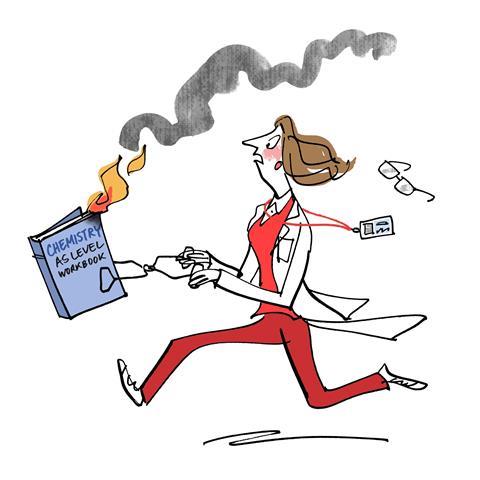Last month brought a tale from a first-time teacher. But how do you keep things fresh after 12 years?
Lab life is complicated: crazy co-workers, clashes over physical space and a pressure to get results are all commonplace. Twelve years ago, I left behind that very traditional research lab life to become a teacher. The co-workers are just as crazy (with an added sprinkling of hormonal teenagers for good measure); the physical space is now a school science lab and the pressure to get results is the same – arguably worse. Still, at least I’m encouraged, even required, to let those teenagers loose with acid and fire!

I was attracted to a career in teaching because of two simple facts: I like chemistry and I like talking. As great as my academic research lab mates were, I found long hours spent with bubbling flasks, running columns and waiting for NMR spectra more than a little lonely. I need more conversations in a day. Fortunately, teenagers are curious creatures who ask the very best and the very worst questions. The things we take for granted as expert chemists are anything but obvious to kids beginning their chemistry journey. To the young, chemistry can seem like impenetrable and baffling hieroglyphics. Some of their questions – ‘Why is water not in the periodic table?’ – have easy answers. Others definitely aren’t – especially when they ask ‘Why are we learning this?’ and that happens to be your exact same thought.
A chemistry teacher is a master of keeping plates spinning, simultaneously managing group dynamics, health and safety, exploding pens, missing exercise books and tummy aches. After a decade of teaching, my lab coat pockets are filled with stray crocodile clips, whiteboard pens, spatulas and giant erasers. I can detect the hiss of an unlit Bunsen burner and spot safety specs perched on top of heads at great distance and across the hustle and bustle of a busy school lab. I can switch between advanced concepts and simple ideas with ease. I’ve learned to dread teaching electricity (dodgy wires and loose bulbs) and anything involving live creatures (‘We had 30 woodlice when we started the lesson and we will not be leaving until we have 30 woodlice back’). And I’m wise to the chaos that inevitably reigns if there is even the slightest hint of a snowflake outside or a wasp gets into the lab.
That’s not to say chemistry teachers are perfect. We all have tales of the mistakes that inevitably slip in when we’re not on top form. School labs are full of hazards – carelessly discarded bags, kids walking around with lit splints and unidentified colourless liquids spilt across benchtops. I’ve turned tripping over while holding a piece of burning magnesium in tongs into an art form (I invariably manage to land flat on my backside, uninjured but still holding it). And curse words are still uttered when I realise a blob of molten potassium chlorate from the ‘screaming jelly baby’ demo has inevitably found its way around my lab coat and is slowly smouldering its way through my cardigan.
Yet these moments are all worth it. It’s an immense privilege to spend such important formative years with young people. As a teacher, you meet them as wide-eyed 11-year-olds in oversized blazers and it seems that in the blink of an eye you’re waving them off into the world. Undergraduate chemists regularly cite their chemistry teacher as their inspiration for choosing a degree in chemical sciences. Of course, most of the kids who pass through our labs won’t become chemists, but they will be a little changed by the time they spend in our care, leaving more scientifically-literate and with a few more tales to tell. The highs are high, the lows are very low, but teaching is never boring.












No comments yet